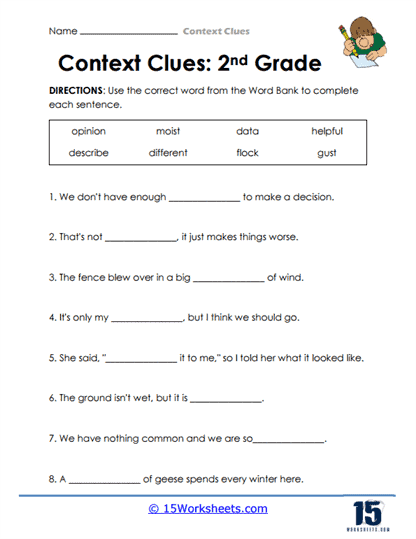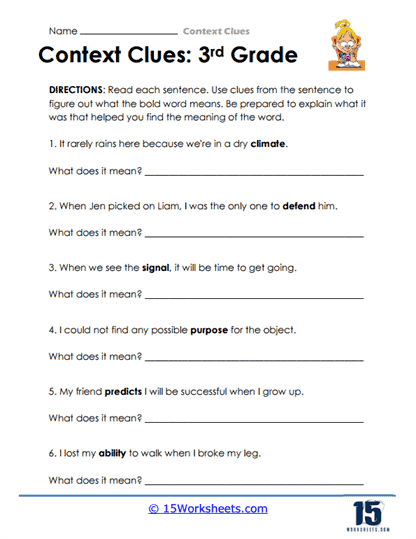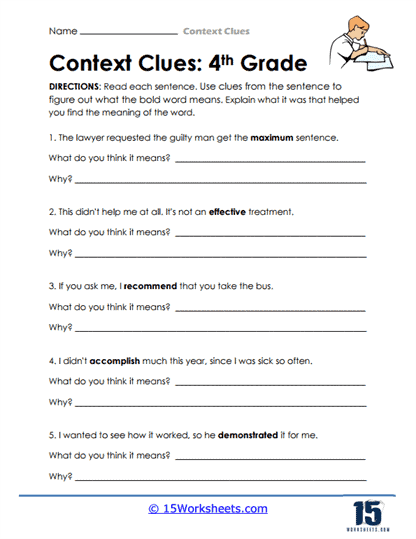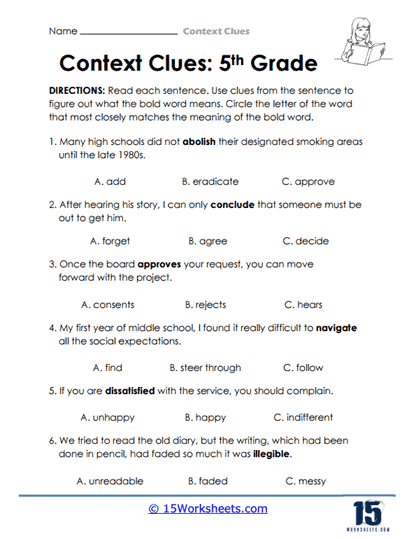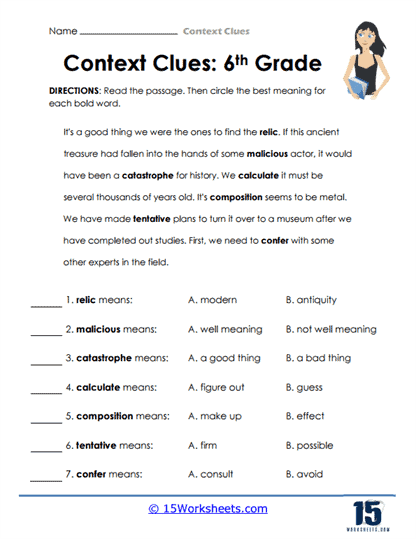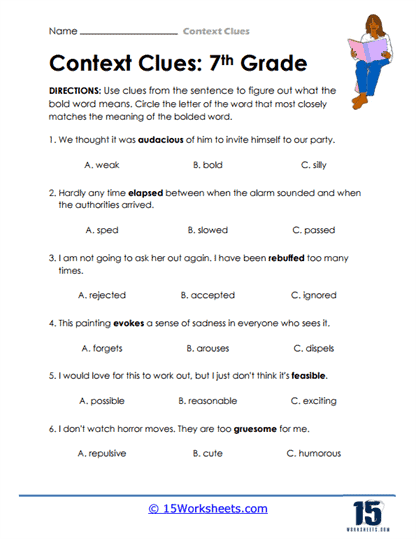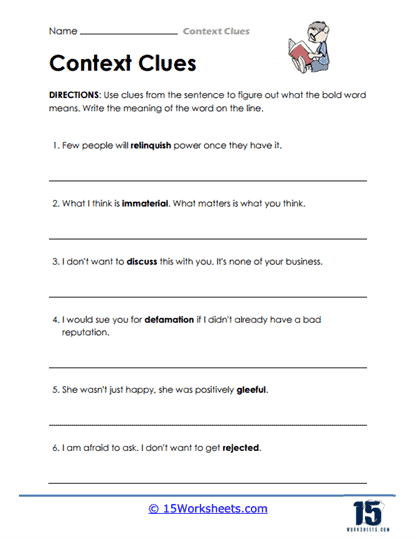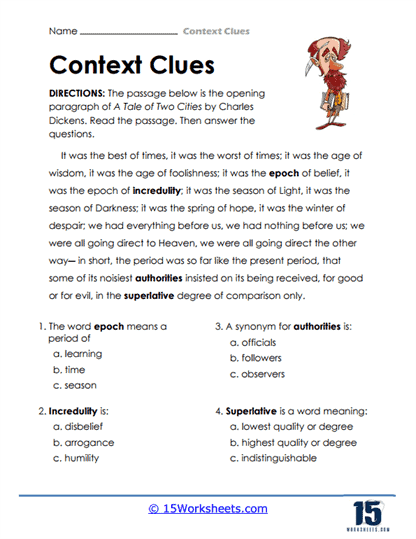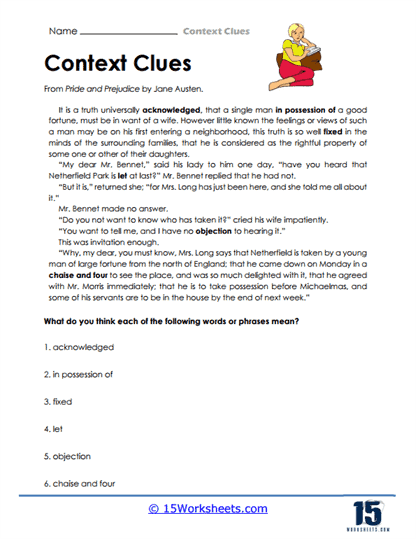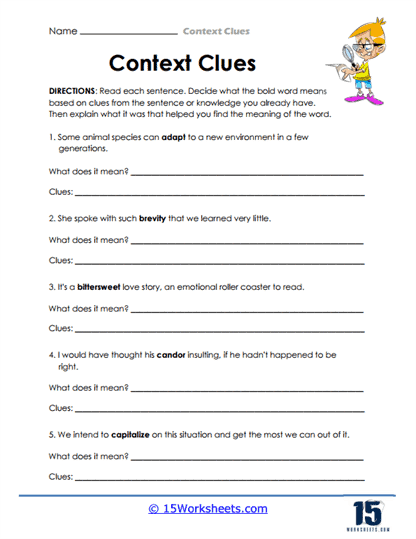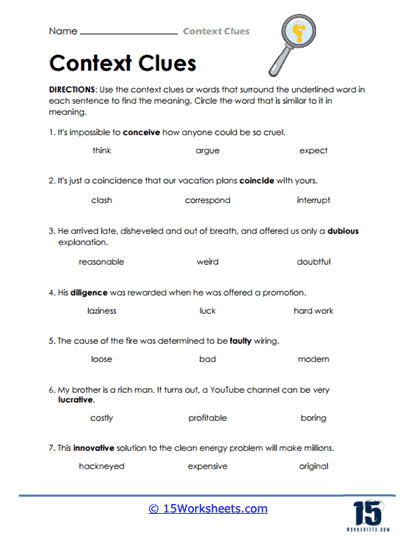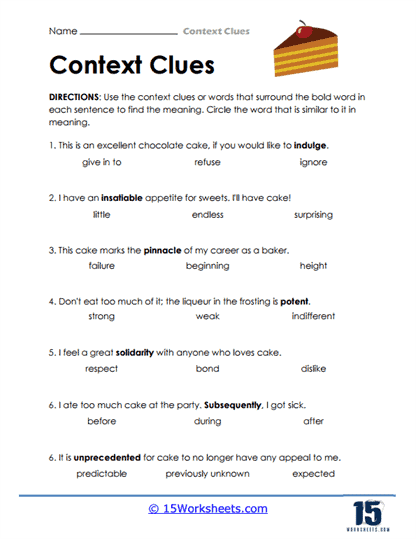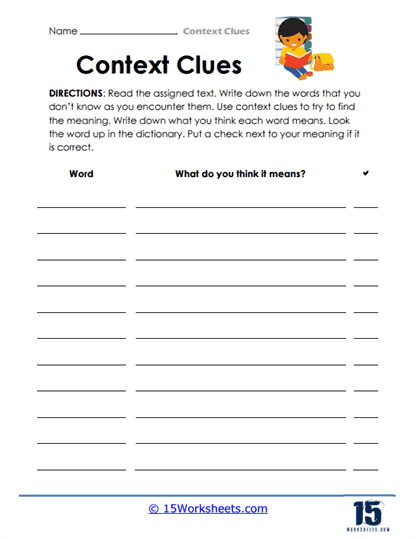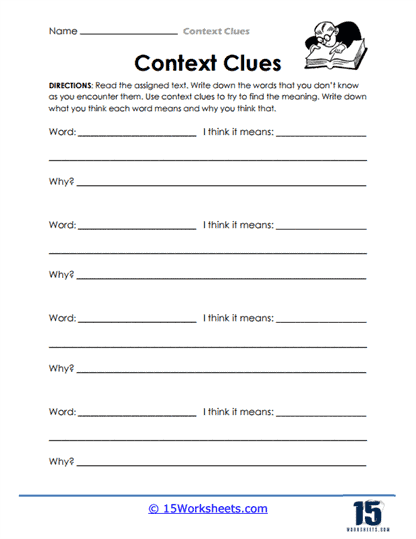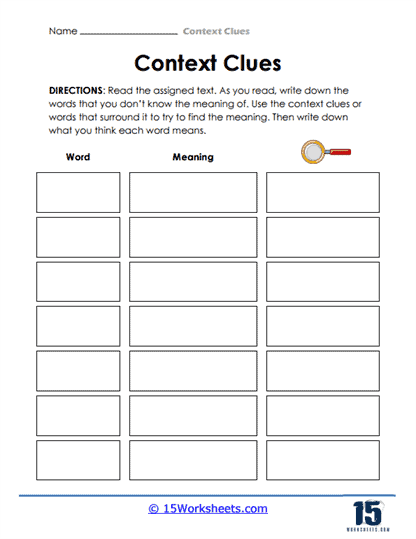Context Clues Worksheets
All About These 15 Worksheets
These worksheets can help you improve your reading comprehension skills by using the clues or hints that are given in the surrounding words and sentences of a text. When you read a story or an article, sometimes you may come across words that you don’t know the meaning of. Instead of looking up every word in the dictionary, you can use context clues to figure out the meaning of those words.
Context clues are like little hints or clues that the author gives you within the text to help you understand the meaning of unfamiliar words. These clues can come in different forms, such as:
Definitions – The author may directly explain the meaning of a word in the sentence itself. For example, they may say, “The dog was very ravenous, which means it was extremely hungry.”
Synonyms – The author may use a word with a similar meaning to the unfamiliar word. For instance, they may say, “She was jubilant and couldn’t stop smiling,” where jubilant means very happy or excited.
Antonyms – The author may use a word with the opposite meaning of the unfamiliar word. For example, they may say, “The storm caused chaos and confusion among the passengers,” where chaos means disorder or confusion.
Examples – The author may provide examples or give more information that helps you understand the meaning. For instance, they may say, “The marathon runner was incredibly resilient. Even when she fell, she quickly got back up and kept running,” where resilient means able to bounce back or recover quickly.
Most of these activities will provide you with short passages or sentences where you have to identify and analyze these context clues to determine the meaning of specific words. They help you practice using these clues and become better at figuring out the meaning of unfamiliar words based on the context in which they are used. This skill is important for improving your reading comprehension and becoming a better reader overall.
How Can Context Clues Help You Understand What You Are Reading?
Understanding what you’re reading is an important skill, and context clues play a crucial role in helping you achieve that understanding. Context clues are valuable tools that provide hints and information within the text to assist you in comprehending the meaning of unfamiliar words or phrases.
When you come across a word that you don’t know while reading, context clues can provide you with hints about its meaning. Instead of immediately reaching for a dictionary or asking someone for help, you can pause and examine the surrounding words and sentences to gather clues. These clues can come in various forms, such as definitions, synonyms, antonyms, or examples. By carefully analyzing the context in which the word is used, you can make an educated guess about its definition and enhance your comprehension of the text.
Context clues are not only helpful for understanding individual words, but they also contribute to your overall comprehension of the text. When you can decipher the meanings of unknown words using context clues, you can better grasp the main ideas and details of what you’re reading. As a result, your ability to comprehend and retain information from the text improves.
Moreover, utilizing context clues helps in the development of your vocabulary. As you encounter unfamiliar words and rely on context clues to determine their meanings, you expand your word knowledge. You learn new words and their nuances, which enables you to express yourself more precisely and understand a wider range of texts. Context clues provide a valuable opportunity for vocabulary growth and enhancement.
Fluency in reading is another area where context clues prove beneficial. When you can quickly identify and understand unknown words, your reading becomes more fluent. Instead of getting stuck on unfamiliar terms, you can seamlessly incorporate context clues to keep the flow of reading going. This smooth and uninterrupted reading experience improves your overall reading fluency and enjoyment.
One of the advantages of context clues is that they foster independent learning. Instead of relying solely on external sources, such as dictionaries or others for help, you can actively engage with the text and use the surrounding context to decipher word meanings on your own. This empowers you as a reader and cultivates a sense of self-reliance and confidence in your reading abilities. With practice, you become more adept at using context clues, allowing you to tackle new texts with increased independence.
How Does This Work?
Example 1 – “The cat was incredibly nimble as it effortlessly leaped from branch to branch, displaying its agility.”
Context Clues: The word “nimble” is used to describe the cat’s actions. The sentence mentions that the cat is leaping from branch to branch and displaying its agility.
Using Context Clues: Based on the context, we can infer that “nimble” means the cat is quick, light-footed, and able to move easily. The context clues of leaping, branch to branch, and agility all suggest the cat’s physical dexterity and speed.
Inference: “Nimble” means the cat is able to move quickly and easily.
Example 2 – “The storm brought torrential rain, thunder, and lightning, causing everyone to seek shelter indoors.”
Context Clues: The sentence describes the storm and its effects. It mentions “torrential rain,” “thunder,” and “lightning,” and states that everyone sought shelter indoors.
Using Context Clues: From the context, we can understand that “torrential rain” implies heavy and intense rainfall. The presence of “thunder” and “lightning” suggests a strong and powerful storm. Additionally, the fact that everyone sought shelter indoors indicates that the storm was potentially dangerous.
Inference: “Torrential” means heavy and intense, describing the heavy rainfall associated with the storm.
Example 3 – “The teacher praised Sarah for her impeccable handwriting; each letter was neatly formed and beautifully aligned on the page.”
Context Clues: The teacher praises Sarah for her handwriting. The sentence describes her handwriting as “impeccable,” mentions that each letter was neatly formed, and emphasizes the alignment on the page.
Using Context Clues: Based on the context, we can infer that “impeccable” means Sarah’s handwriting is flawless, perfect, and exceptionally neat. The clues of each letter being neatly formed and beautifully aligned indicate a high level of precision and attention to detail.
Inference: “Impeccable” means Sarah’s handwriting is flawless, perfect, and exceptionally neat.

